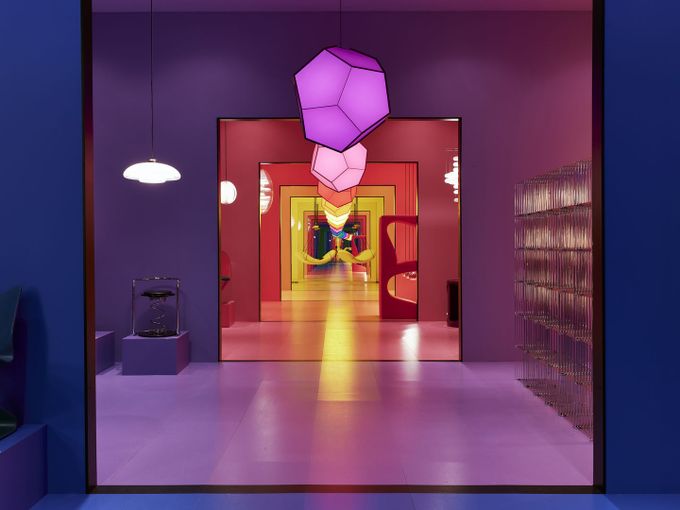I had complete creative freedom
Here We Are! Women in Design 1900 – Today

Colour sample imitation leather, 1976
For more than twenty years, Galina Balashova (b. 1931) designed the interiors for all major Soviet spacecraft and space stations. As part of the research for the exhibition »Here We Are! Women in Design 1900 – Today«, curatorial advisor Alyona Sokolnikova asked Balashova about the highlights of her career.
Alyona Sokolnikova: You designed the living and working environments for cosmonauts from 1963 to 1986. What was your biggest challenge?
Galina Balashova: It is very challenging for an architect to design spaces that are intended to be used in zero gravity. I designed orbital module interiors for four different variants of the Soyuz spacecraft, interiors for the Salyut 6, Salyut 7, and Mir space stations, for the Buran space shuttle, as well as the official emblem of the Apollo-Soyuz space mission and various medals and pennons. There were organisational challenges, too. There was no such job title as »interior designer« or »space architect«. Officially, I was employed by the Special Design Bureau No. 1 (OKB-1), which designed all rockets and spaceships for the Soviet Space Programme, as equipment layout engineer. So I was paid only for this work and all of my interior and graphic design projects were done unofficially and at no charge!AS: This must have been very frustrating.
GB: Yes, but it also meant that nobody interfered with my work. I had complete creative freedom, and in all projects I drew from common sense and from my artistic taste, which was backed up by a classical education in architecture. I also studied the cosmonauts’ post-flight feedback very carefully and always did my best to implement improvements.
AS: Was it hard for you as a woman to get this job?
GB: I think it was all about a combination of luck and passion and my willingness to play by the rules. My husband worked as an engineering physicist at OKB-1. He helped me get a job as junior architect at their plant, where I was responsible for the reconstruction of the buildings and the premises as a whole. In 1963, the engineers came up with their design for the first on-board compartment of the Soyuz spaceship, but it was rejected. So they asked me to prepare a new proposal, which I did literally overnight. It was immediately approved. I worked after hours from home for more than a year before I was finally allowed to join the team of spacecraft designers. At one point, I was officially employed as a watchwoman, while also putting the finishing touches to my designs for the Mir spacecraft interiors. During all those years, no one really understood or appreciated what I was doing there. It was as if I was just doodling for the fun of it.
AS: But your projects were truly unique at the time! And you literally had to work in isolation, given the programme´s classified status. What do you think was your greatest achievement in space module environment design?
GB: My priority was to ensure both physical and psychological comfort for the cosmonauts by scaling interiors to the human body. Architecture is always about arranging the spaces in the first place, not the equipment! The other engineers at our bureau didn’t really get that. I also realised that there were two main things you have to keep in mind when designing for zero gravity. Firstly, I used an earthy colour scheme to ensure a clear contrast between a dark, green floor and a light, pale yellow ceiling for better spatial orientation. Secondly, I invented an innovative Velcro fastening system so that the cosmonauts could easily secure all the small items – which would otherwise float around the module – or even anchor themselves to various surfaces.AS: You did many of your work projects in watercolour. I understand that painting is a big passion of yours and that some of your watercolours even made it into space, is that true?
GB: Some of my interior designs had paintings on the walls. When these were approved, I had to give up some of my own watercolour landscapes to contribute to the cause. They went into space and perished when the orbital modules burned up on the way back to Earth.The exhibition ‘Here We Are! Women in Design 1900 – Today’ can be seen at the Vitra Design Museum in Weil am Rhein until 06.03.2021.
Publication Date: 8.2.2022
Images: The Museum of Cosmonautics, Moscow; Philip Meuser;


